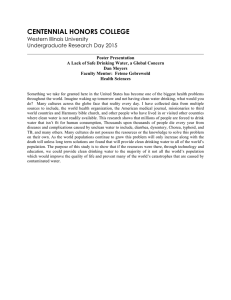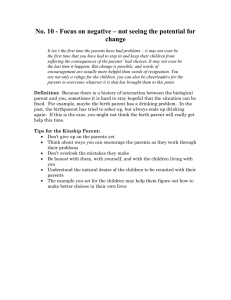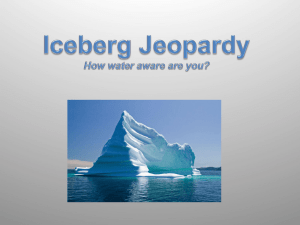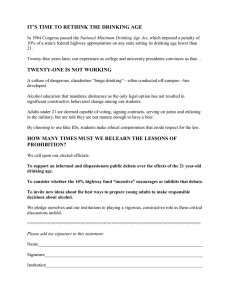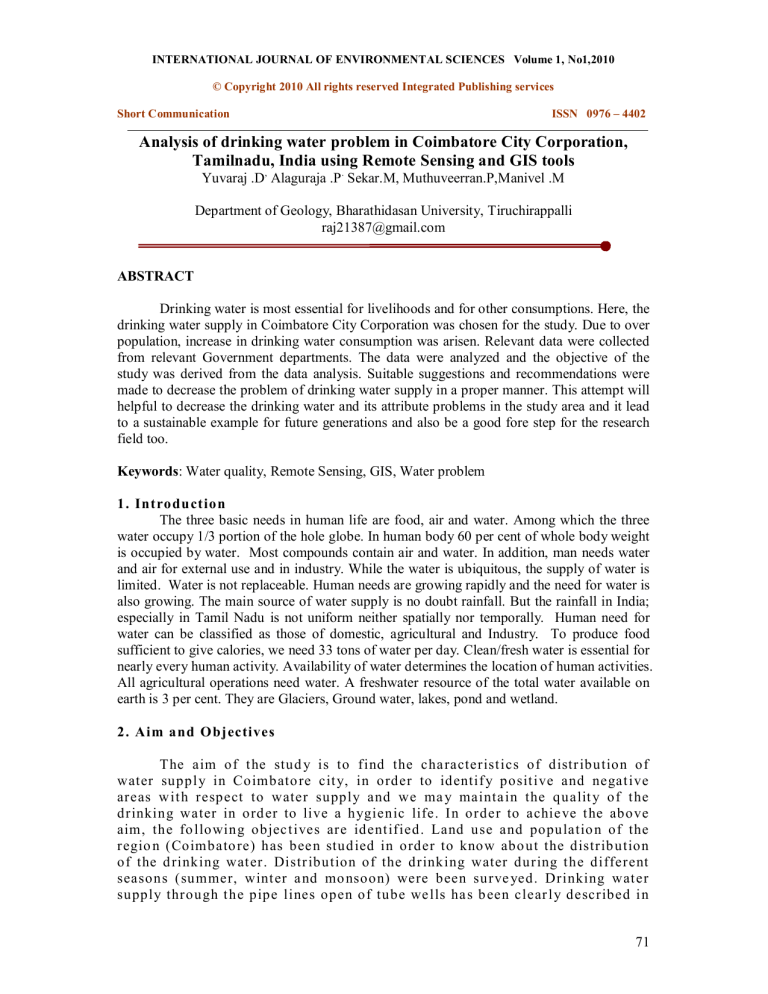
INTERNATIONAL JOURNAL OF ENVIRONMENTAL SCIENCES Volume 1, No1,2010
© Copyright 2010 All rights reserved Integrated Publishing services
Short Communication
ISSN 0976 – 4402
Analysis of drinking water problem in Coimbatore City Corporation,
Tamilnadu, India using Remote Sensing and GIS tools
Yuvaraj .D, Alaguraja .P. Sekar.M, Muthuveerran.P,Manivel .M
Department of Geology, Bharathidasan University, Tiruchirappalli
raj21387@gmail.com
ABSTRACT
Drinking water is most essential for livelihoods and for other consumptions. Here, the
drinking water supply in Coimbatore City Corporation was chosen for the study. Due to over
population, increase in drinking water consumption was arisen. Relevant data were collected
from relevant Government departments. The data were analyzed and the objective of the
study was derived from the data analysis. Suitable suggestions and recommendations were
made to decrease the problem of drinking water supply in a proper manner. This attempt will
helpful to decrease the drinking water and its attribute problems in the study area and it lead
to a sustainable example for future generations and also be a good fore step for the research
field too.
Keywords: Water quality, Remote Sensing, GIS, Water problem
1. Introdu ction
The three basic needs in human life are food, air and water. Among which the three
water occupy 1/3 portion of the hole globe. In human body 60 per cent of whole body weight
is occupied by water. Most compounds contain air and water. In addition, man needs water
and air for external use and in industry. While the water is ubiquitous, the supply of water is
limited. Water is not replaceable. Human needs are growing rapidly and the need for water is
also growing. The main source of water supply is no doubt rainfall. But the rainfall in India;
especially in Tamil Nadu is not uniform neither spatially nor temporally. Human need for
water can be classified as those of domestic, agricultural and Industry. To produce food
sufficient to give calories, we need 33 tons of water per day. Clean/fresh water is essential for
nearly every human activity. Availability of water determines the location of human activities.
All agricultural operations need water. A freshwater resource of the total water available on
earth is 3 per cent. They are Glaciers, Ground water, lakes, pond and wetland.
2. Aim and Objectives
The aim of t he stud y is to find the cha racterist ics of distr ibution of
water suppl y in Coimbato re cit y, in order to identif y posit ive and negat ive
areas w it h respect to water supply and we ma y mainta in the qualit y of t he
drinking water in ord er to live a hygienic life. In order to achie ve t he above
aim, the fo llowing objec t ives are ident ified. Land use and populatio n of the
regio n (Coimbato re) has bee n stud ied in order to know abo ut the distrib ution
of the d rinking wat er. Distr ibution of the drinking water during t he different
seasons (summer, wint er a nd mo nsoon) were been surve yed. Drinking wat er
supply through t he pipe lines open of tube we lls ha s b een clear l y described i n
71
INTERNATIONAL JOURNAL OF ENVIRONMENTAL SCIENCES Volume 1, No1,2010
© Copyright 2010 All rights reserved Integrated Publishing services
Short Communication
ISSN 0976 – 4402
the stud y. Maint e nance of the gro und water level of water b y harvest ing rain
water t hrough pit t echnique is d escr ibed . Data re lat ed to the usage o f water,
water co ntaminat ion and the wa ys and m ea ns of conserving wat er ha s been
co llect ed in order to stress t he point on the conser vatio n of the rene wable
water resource.
2.1 Stud y Area
The present stud y is concerned wit h the sp atial distr ibution of
drinking water supply in Co imbatore cit y. The Coimbato re cit y fact is urban
water supply b y p ip e line s, Lorries and handcart s or bu llock carts. The
drinking wat er supply t hrough lorry se rvice to Chennai is dela yed when
co mpared to other c it ies. Coimbatore is t he t hird lar gest cit y in T amil Nadu,
of more than t he populatio n of Coimbatore Cit y is 9.3 la khs of t he 2001
ce nsus. T here are more than 3 0,000 tiny small, med ium and lar ge industrie s
and text ile mills. The cit y is known for its entrep re neu rs hip of its res idents.
The climate is comfo rtable rou nd the year.
Figure 1. Location map of the study area
72
INTERNATIONAL JOURNAL OF ENVIRONMENTAL SCIENCES Volume 1, No1,2010
© Copyright 2010 All rights reserved Integrated Publishing services
Short Communication
ISSN 0976 – 4402
Fig ure 2 . Administrat ive boundar y of t he stud y area
3. Metho dology
The nature of drinking w ater suppl y in Coimbatore has been found b y
using t he quest io nnair e based data. Ra ndom samp ling met hod has been
ad opted in the se lect ion of samp les people of d iffere nt socia l status ha ve
been inter viewed to get relevant info rmatio n. Collected information wa s
ma nipulated, cartograp hica lly as well a s stat ist ic all y so as to expla in var iou s
aspect s of wat er supp ly in Co imbatore. Esp ecia lly t he locat io n a nd
distrib utiona l aspects of co nsumption, econo mic status and distr ibu tio n of
different sources are exp lained cartographica ll y. Rainfall t emperature data
and popu lat ion data are a lso rep rese nt ed b y diagrams and carto grap hic
illustrat io ns. In order to establis h t he relat io ns hip betwee n populatio n,
co nsumptio n and amenit ie s, sem i­q uantit ative tec hniqu es have b een adop ted.
Rainfa ll and temperatu re data are correlat ed to find ou t the evapo­
transpirat io n a nd to find out the recharge leve ls in Co imbato re Cit y
Municipa l Corporation limit s w it h t he help of methods ava ilable from Ind ia n
researc hes, most importantly, t hose o f Bhattachar ya et al (1 953), Chatu ved i
(1944),
and
Tamil
Nadu
Agric ultural
Univers it y,
Coimbatore
(1990).S tatist ical met hods emplo yed in the stud y are e xplained in t he
rele vant c hap ters, ho we ver, the stud y is ess ent ia lly qualitat ive thou gh certai n
amount of quantific at ion has bee n attempted.
73
INTERNATIONAL JOURNAL OF ENVIRONMENTAL SCIENCES Volume 1, No1,2010
© Copyright 2010 All rights reserved Integrated Publishing services
Short Communication
ISSN 0976 – 4402
4. Results and Conclusion
The growing populat ion in t he c it y o f Coimb atore, the do mestic need
for drinking w ater supp ly ahs increa sed while no n­d omestic u ses ha ve s hown
increas ing d emand wit h incr ea sing industr ies, co nstruct ions and transport.
The interest in u rb an wat er supply is widesp read. It appears that t her e is an
imb alance in Dr inking w ater supply and d emand and that is also perennial i n
nature. The natu re and develop ment o f water pipeline net work at all re gio n
levels, in differ ent parts of the world, had a lso been carr ied out b y t he
geograp hers, economist s and engineers.
Because of the enviro nme ntal
changes, almo st ever y part of the world is fac ing t his problem, and hence, in
recent ye ars, t he stud y of drinking wat er supply in u rb an s ys tems has gained
imp ortanc e and the number of scho lars a nal yzing t he var ious aspects of this
problem has increa sed. The p resent stud y has deal wit h t he drinking water
supply in Coimb atore Cit y Co rporation at a micro level in a s im ilar vein to
mo st such stud ies. Coimbato re is the se cond lar gest tow n in Tam il Nadu. It is
an ind ustrial tow n gro wing in it s size a nd popu lat ion rap idl y.
The
occup ationa l structure o f the c it y a lso has drast icall y cha nged from p rimar y
to seco ndar y a nd no w to tertiar y. The populatio n has almo st doubled in one
decade.All polit ica l p art y should take step to join the rivers in the co untr y to
avoid wastage and to incr ease t he utilit y o f the water. More than policie s a nd
pla nning, prop er awarene ss o n sa fe drinking water among t he peop le should
be created. The conservat io n of wat er is a collect ive respons ibilit y of al l
cit izens of Ind ia. Let us all jo in toget he r to co nser ve a nd protect water.The
primary and secondar y data w hic h have bee n co llected from respondent s a nd
respect ive department s are ver y much useful in find ing t he consump tio n rate
and nature o f pipeline netwo rk a nd its distrib ution. The spatial distrib ution
and development o f drinking wat er su pply spat ia l d istr ibution a nd
develo pment of drinking wat er supp ly ha ve also been a nal yzed from thes e
data. The sp atial patter n of drinking w ater supp ly b y var ied mea ns, the
distrib ution a nd the d eve lopment o ver t he ye ar s are int imat e ly associat ed
with t he growing connect ions s hou ld be improved in all five zones b ecause in
all t her e are inad equ acie s. A nu mber of wells ha ve b een located in the
heavil y populated areas and areas w here p ro tected drinking water supply is
distrib uted. The detailed anal ys is in t he fir st four chapters cle ar l y e xpo ses
the imbalance in the distrib ution of different drinking water supply means.
The follow ing are a few su gge st ions towards imp ro ving t he drinking wat er
supply in Co imbatore cit y. In co nc lusion, the aut hor would like to p oint out
that Coimbato re protected d rinking w ater supply s yst em has done ne ed y. The
scho lar wou ld like to recommend that the var ious urban s yst em of the
Coimb atore Cit y w hic h comes clo sed to an e ffic ient s ystem, a lt hough t here
are yet some defic ienc ies.
5. References
74
INTERNATIONAL JOURNAL OF ENVIRONMENTAL SCIENCES Volume 1, No1,2010
© Copyright 2010 All rights reserved Integrated Publishing services
Short Communication
ISSN 0976 – 4402
American Society for Testing and Materials. 1978. Manual on Water (TD 353 M35) ­
American Water Works Association. 1990. Water Quality and Treatment; a Handbook of
Community Water Supplies (TD 430 W365 1990)
Arkansas Soil and Water Conservation Commission, 1992, Rules for the Protection and
Management of Ground Water: Little Rock, AR, 12 p.
Arkansas Water Well Construction Commission, Revised 1994, Arkansas Water Well
Construction Code Rules and Regulations: Little Rock, AR, 29 p.
Arkansas Soil and Water Conservation Commission 101 E. Capitol, Suite 350
Little Rock, AR 72201 (501) 382­1611
Eversoll, D.A., Hay, D.R., and Trembaly, R.J., 1995, Guidelines for Decommissioning
Water Wells­­How to Plug Water Wells: Conservation and Survey Division, Institute of
Agriculture and Natural Resources, University of Nebraska­Lincoln, Miscellaneous
Publication No. 37, 22 p.
Fresenius Water Analysis; A Practical Guide to Physio­chemical, Chemical and
Microbiological Water Examination and Quality Assurance (TD 380 W327 1988)
Ghebtsawi ­ Tsighe, T. (1990). ’Drinking water source protection problems: the case of
Tanzania’. In: Working meeting on drinking water source protection, 30 June ­ 1 July, 1990.
The Hague, The Netherlands, IRC International Water and Sanitation Centre.
Glanville, Tom, 1992, Successfully Plugging Your Abandoned Well: Iowa State University
Extension, Ames, Iowa, Publication # Pm­1328, accessed August 17, 1998.
Hofkes, E.H., Huisman, L., Sundarsen, B.B., De Azevedo Netto, J.M. and Lanoix, J.N.
(1986). Small community water supplies. (Technical Paper Series; no. 18). The Hague, The
Netherlands, IRC International Water and Sanitation Centre.
Hubbs, S.A. (1985) Understanding water supply and treatment for individual and small
community systems. Washington, DC, USA, Volunteers in Technical Assistance.
International Reference Centre for Community Water Supply and Sanitation. 1986.
Interwater Directory of Sources of Information and Documentation on Community Water
Supply and Sanitation (ref TD 327 I58)
Langenegger . O (1987). Groundwater quality in rural areas of western Africa. Abidjan, Ivory
Coast, World Bank Regional Water and Sanitation Group.
Lewis, W.J., Farr, J.L., and Foster, S.S.D. (1980b). ’The pollution hazard to village water
supplies in eastern Botswana’. In : Proceedings of the Institute of Civel Engineers. Part2,
vol.69.
Lloyd, B. (1982). ’Water quality surveillance’. In: Waterlines, vol.1, no.2, p.19­23.
75
INTERNATIONAL JOURNAL OF ENVIRONMENTAL SCIENCES Volume 1, No1,2010
© Copyright 2010 All rights reserved Integrated Publishing services
Short Communication
ISSN 0976 – 4402
Louisiana Department of Transportation and Development, 1985, Water Well Rules,
Regulations and Standards ­ State of Louisiana: Baton Rouge, LA, Public Works and Flood
Control Directorate ­ Water Resources Section, 140 p.
Miller (1992). Water Quality and Availability: A Reference Handbook (ref TD 223 M53)
Missouri Department of Natural Resources, 1987, Missouri Private Well Construction
Standards ­­ Rules and Organizational Structure for RSM 256.600: Rolla, MO, Division of
Geology and Land Survey, 35 p.
Nid hya P. and Venmat hi
A., 1999, impact of tanner y effluent o n
environment a l qualit y in Dind igul, Pro ceedings, Ind ia n Enviro nme nta l
Congre ss 2003 – March towards Green Ea rth, 2 0­21 December 200 3.
Nillsson A. (1988). Groundwater dams for small­scale water supply. London, UK,
Intermediate Technology Publications.
Oklahoma Department of Environmental Science, Public Water Supply Construction
Standards: Oklahoma City, OK, Oklahoma Department of Environmental Quality, 252:625.
Oklahoma Waster Resources Board, Oklahoma Water Resources Board Regulations:
Oklahoma City, OK, Oklahoma Water Resources Board, 785:35, Chapter 35, Subchapter 11,
Sections 1 ­ 3, pp. 16 ­ 19.
Office of Compliance and Enforcement, Compliance Support Division, 1997, Regulations for
Well Drillers and Water Well Pump Installers: Texas Natural Resource Conservation
Commission, Austin, TX, pp. 32­73.
Rogers, N. (1985). Water sources and their protection : a guide to community water source
protection and designs for a spring protection and well digging programme. Oxford, UK.
Solley, W.B., Pierce, R.R., and Perlman, H.A., 1993, Estimated use of water in the United
States in 1990: U.S. Geological Survey Circular 1081, 76 p.
U.S. Department of Agriculture ­­ Natural Resources Conservation Service, Conservation
Practice Standards and Specifications ­ Well Decommissioning ­ Code 351.
U.S. Environmental Protection Agency, 1975, Manual of Water Well Construction Practices:
Office of Water Supply, Washington, DC, EPA 570/9­75­001
76


